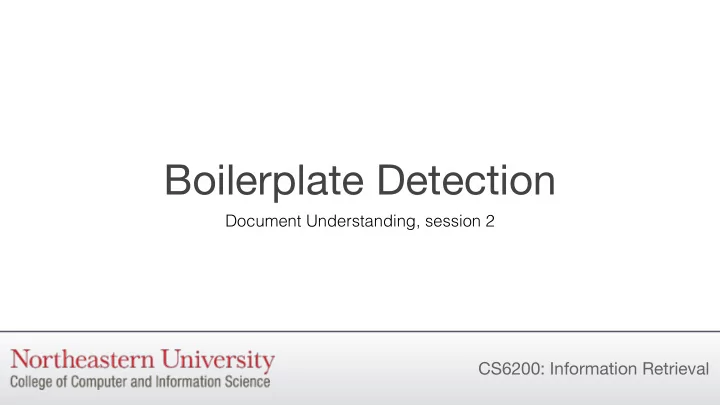

Boilerplate Detection Document Understanding, session 2 CS6200: Information Retrieval
Document Boilerplate BOILERPLATE In a naive retrieval model, we treat all text on the page identically. This TITLE doesn’t match real page content well. THUMB NAIL • Site menus, ads, and other BOILERPLATE BOILERPLATE SUMMARY “boilerplate” have little bearing on the topic of the page. • Some regions of the page, such as the title and headings, deserve extra emphasis compared to the main CONTENT page content. http://www.imdb.com/title/tt2084970
Document Zones E-mail Fields In order to account for different document zones, we label document text based on its zone type in the index. In structured documents such as email, HTML Token Ranges we might create a separate index for Title each field. In a free-text document, we store zone Summary information as a label for a contiguous region of the document. In HTML, this often means labeling a subtree of the DOM based on its offset within the file.
Zone Identification Many approaches to identifying the zones of a web page have been successfully implemented. • Rule- or template-based zone identification, for hand-tailored or automatically learned rules. May involve building a template for each major web domain (Wikipedia and IMDB need different rules). • Render the HTML and use image processing on the rendered page to find rectangular regions of interest. Use visual cues such as font size, horizontal lines, etc. Then find the HTML code which produced the regions of interest. • Simple heuristics based on text features also work well, and are simpler to implement.
Heuristic-based Boilerplate Detection Boilerplate Algorithm Kohlschütter et al (2010) developed a 1. Split an HTML document into successful approach based on the contiguous blocks of text and A observation that content and tags; discard other document tags. boilerplate have very different structural patterns, and simple 2. Extract textual features (described heuristic features can often tell the next). difference. 3. Train a machine learning classifier They also provided a fast to label each block as CONTENT or implementation which is used in many BOILERPLATE based on the places. features. Paper, data, and implementation at: http://www.l3s.de/~kohlschuetter/boilerplate/
Features for Boilerplate Detection In contrast to prior work, they largely Feature Discussion ignore bag-of-words and deep Binary features indicating whether Structural Tag document structural features. the block is enclosed by tags such Presence as H1 , H2 , H3 , P , DIV , or A . Surprisingly, they perform as well or Block The absolute and relative position of Position the block on the page. better than methods that use these Average word length, average more complex features, or that use Text Features sentence length, number of words. sophisticated image processing Text Density Number of words divided by number techniques. of lines Number of words in A tags divided They conclude that the majority of Link Density by number of words HTML blocks are either boilerplate Number of capitalized or all-caps Heuristic “short text” blocks, or content “long words, number of date/time tokens, Features text” blocks. and ratios of these to other words.
Wrapping Up Ignoring document boilerplate text is important for improving retrieval performance. This text can easily mislead a ranker. It’s also common to weight text differently when it comes from different zones. For instance, title terms often count more than standard content terms. This zone information can either be stored in a separate index for each field type, or with labeled document regions in a full text index.
Recommend
More recommend